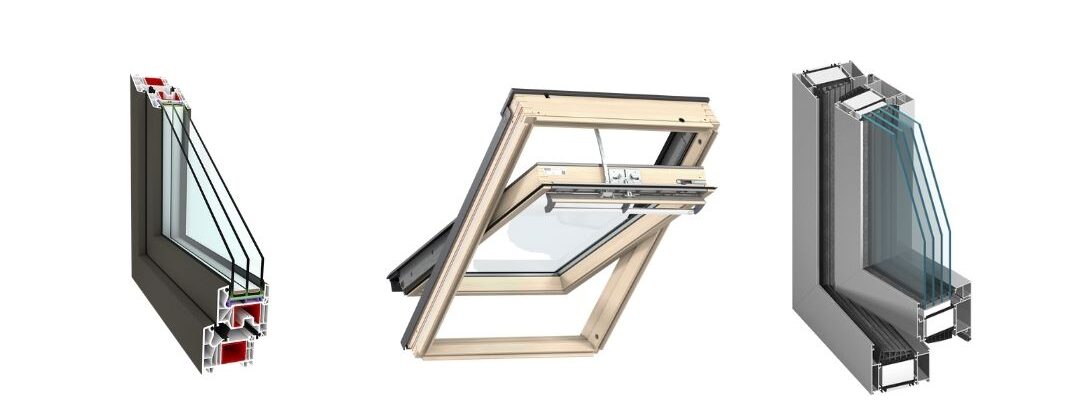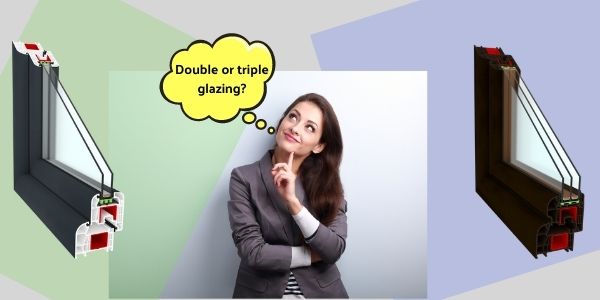Choosing windows is a difficult task. When you buy them, you want to be sure that you select a product of optimal parameters at a reasonable price. But how to do it properly when there’s such a range of window types to pick from and it is so hard to know where to start? Besides, how do you know you aren’t being overcharged and that the windows you choose will stand the test of time? Well, that’s tricky. But fortunately, we have loads of useful advice for you!
In this blog post, you will find necessary information that may come in handy when deciding on the right windows for your home. Of course, no one knows better than you what kind of windows you want to equip your house with. But in order to make a wise choice, you have to get a sense of terms and factors that affect both the appearance and the overall level of comfort in your home. So here’s a quick guide on how to read the technical parameters of windows!
Window frames
Window frames tend to come in one of three main choices: uPVC (Unplasticized Poly Vinyl Chloride), timber, or aluminium. Among those, the uPVC ones seem to be dominant. There are a few reasons for such a state of things: they’re usually the cheapest option, manufactured at scale and dimensionally stable. They are pre-coloured in a range of finishes and require very little maintenance. When it comes to disadvantages, uPVC window frames in dark colours may change their shade under the influence of UV rays and unfavourable weather conditions – generally, in warm climate and temperatures above 25 degrees C. They cannot be repaired when scratched or damaged – in such a case, they must be replaced.

In the case of timber windows, the biggest value is their exceptional aesthetics. To be honest, there is no better material for replicating a traditional style and detailing than timber. Besides, timber windows can boast impressive technical parameters, air tightness and sound insulation. The biggest weakness is the need for repetitive maintenance procedures (every 5-10 years) and quite high prices.
Aluminium windows are, on the other hand, completely maintenance free. They’re totally dimensionally stable and strong – they are able to achieve very slim frame widths and at the same time heavy triple glazing. The argument against them is mostly their price – they can be up to 70% more expensive than uPVC windows!
Energy efficiency
First of all, your windows should enhance the performance of your home – not take it away from it. We all realise that heat escapes through the glass surfaces faster than through the walls. So in order to keep the optimal temperature of your home interior and improve the building’s energy balance, it is worth investing in energy-efficient windows. When choosing them, keep the following parameters in mind:

Uw (U-value) – the window’s heat transfer coefficient. It informs you about the level of window thermal insulation. The Uw (U-value) shows how much heat will penetrate 1 m2 of a window in one hour, with a difference between the temperatures on both sides of the window of one degree. This means that the lower the Uw coefficient, the better the window’s thermal insulation is.

Ug – the heat transfer coefficient of the glazing unit. The higher it is, the more sun radiation reaches the interior of your house. The lower the Ug coefficient, the smaller the heat losses and greater savings during the heating period. In case of Ug, the number and type of glazing are essential. Nowadays, the most popular windows are the triple-glazed ones, but double-glazed windows are still common. In both cases, it is necessary to equip the window with a warm edge spacer and the right type of gas that fills the pane’s spaces. For your information: the lowest energy losses are ensured by the so-called passive windows (the Uw starts from 0.9 W m2/k.

Uf – the heat transfer coefficient in the window frame. This parameter is influenced by the width of the applied window profiles. The most common material used in windows is steel. But although it improves the mechanical strength of the plastic, it “gives off” more heat, which is not beneficial either. Therefore, the use of composite filling gives a better thermal insulation result. The minimum value you should pay attention to is 1.1 W / (m2K).

Lt – the light transmittance coefficient. It is the amount of sunlight entering the room through the glazing unit. The Lt value depends on the thickness of the glass, the composition of the raw materials in the glass mass and the coating system used. This parameter is defined as a percentage (%). The higher the percentage of the transmitted light, the brighter the room.
Remember about the above mentioned parameters when buying new windows. In this way, you can make sure that the selected windows will provide a high level of thermal insulation and guarantee the right building’s energy balance. One more important tip: before buying, pay close attention to the U parameter for whole windows (Uw), and not only for the glazing unit (Ug)!
Window profiles
A window profile is, in short, the structure that holds the glass. This is the most critical element of the entire window and it largely determines whether the window has good thermal insulation properties, protects against unwanted guests (e.g. in anti-burglary windows) and whether it meets the aesthetic values or not.
Wooden windows have a uniform structure, while uPVC and aluminium windows have chambers that affect thermal insulation. The walls of the chambers have different thickness, which determines the class of the profile. The thickness of the profiles is defined by the PN-EN 12608: 2004 standard.
In the case of Class A, the value shall be at least 2.8 mm. In turn, in class B, this parameter must be slightly lower – minimum 2.5 mm. Class C is intended for profiles that do not meet the above conditions.
The second value used for the classification of profiles is the thickness of the invisible profile walls. For class A it is at least 2.5 mm, and for class B it is at least 2 mm. Products that do not comply with these conditions are assigned to class C.
Obviously, Class A profiles are the best choice. They will provide us with the best window insulation. However, the selection of the so-called “warm” window should not be based only on comparing the classes of window profiles. You should also pay attention to such elements as the number of chambers, gaskets, fittings, spacer frames, glazing units and – already mentioned – the heat transfer coefficient (Uw).
Glazing units
Let’s make it clear: choosing the right type of the glazing unit will make a dramatic difference to the comfort of your home – as well as to your bills.

The glazing unit consists of two or three panes of glass, 4 or 6 mm (sometimes even 8 mm) thick, separated by an edge spacer that keeps them in a vertical position at the appropriate distance. The width of the chamber is 10-18 mm, most often 16 mm. Its interior is filled with argon known for good insulating properties.
The most obvious factor to consider when choosing between double and triple-glazed windows is where your home is located. Depending on the climate (e.g. Southern Europe) and the average temperature prevailing in the year, buying double-glazed windows may be a good choice. Each pane absorbs some light, which is why these windows are brighter (Lt 77-80%). As double-glazed windows let more heat from the sun to penetrate the home interior, the rooms will heat up faster. In colder climates, you will benefit more from the introduction of triple-glazed windows. This is particularly relevant in the case of windows that are not exposed to a great deal of sun during the winter months.
Another important factor in your decision-making process is the price. At first sight, double-glazed windows seem to be a better choice when you want to save money. But is it really so? As triple glazing units are filled with gas (argon), they are characterised by low thermal permeability and often used in passive (energy-saving) houses. In such a case, the cost of the window will pay off much faster when we compare it to the expenses we would have to bear for heating or electricity.
Window chambers
Last but not least, it is the number of chambers in the window that affects its thermal insulation. When choosing energy-saving (passive) windows, it is worth knowing that they most often come with a six-chamber structure and a built-in depth of over 80 mm. However, remember that it is not the number of chambers that is the most important for energy-saving windows. It is the quality of the materials used inside the window that influences the heat transfer coefficient (Uw).
Final words
There seems to be a lot of knowledge to absorb in this post, isn’t there? Well, it is all certainly worth taking into account if you want to effectively optimise the purchase process of your windows. We hope it will help you to save your money and allow you to get to know the product better. It is indisputable that the benefits offered by windows are integral to the comfort, convenience and safety of your home. Well-chosen windows are a vital investment!